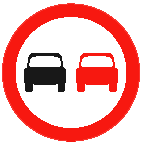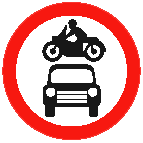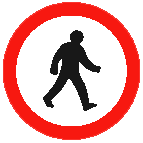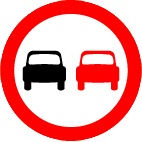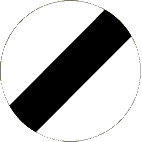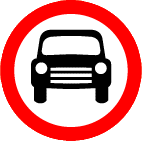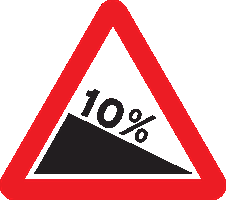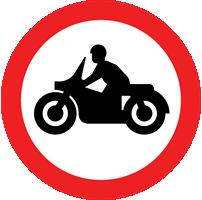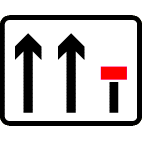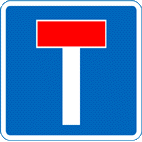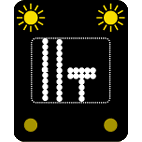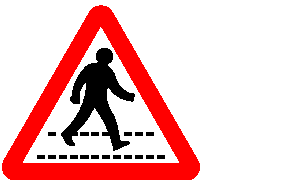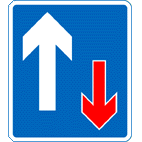You have 57 minutes to answer 50 multiple choice theory test questions. You need to answer at least 43 out of 50 questions correctly to pass. You can review your answer after each question or you can review all of your answers at the end of the test. Best of luck!
Test Quick View
Click on an answer to view the correct choice along with the explanation.
Correct Answer: A
Explanation: As you begin to think about overtaking, ask yourself if it's really necessary. If you can't see well ahead stay back and wait for a safer place to pull out.
Explanation: As you begin to think about overtaking, ask yourself if it's really necessary. If you can't see well ahead stay back and wait for a safer place to pull out.
2. A long, heavily-laden lorry is taking a long time to overtake you. What should you do?
Mark one answer
B
C
D
Correct Answer: C
Explanation: A long lorry with a heavy load will need more time to pass you than a car, especially on an uphill stretch of road. Slow down and allow the lorry to pass.
Explanation: A long lorry with a heavy load will need more time to pass you than a car, especially on an uphill stretch of road. Slow down and allow the lorry to pass.
Correct Answer: A
Explanation: Adjust your speed in good time and select the correct gear for your speed. Going too fast into the bend could cause you to lose control. Braking late and harshly while changing direction reduces your vehicle's grip on the road, and is likely to cause a skid.
Explanation: Adjust your speed in good time and select the correct gear for your speed. Going too fast into the bend could cause you to lose control. Braking late and harshly while changing direction reduces your vehicle's grip on the road, and is likely to cause a skid.
4. An elderly person's driving ability could be affected because they may be unable to
Mark one answer
B
C
D
Correct Answer: C
Explanation: Be tolerant of older drivers. Poor eyesight and hearing could affect the speed with which they react to a hazard and may cause them to be hesitant.
Explanation: Be tolerant of older drivers. Poor eyesight and hearing could affect the speed with which they react to a hazard and may cause them to be hesitant.
Correct Answer: B
Explanation: If a school crossing patrol steps out into the road with a stop sign you must stop. Don't wave anyone across the road and don't get impatient or rev your engine.
Explanation: If a school crossing patrol steps out into the road with a stop sign you must stop. Don't wave anyone across the road and don't get impatient or rev your engine.
Correct Answer: D
Explanation: Vehicles that are used to carry children to and from school will be travelling at busy times of the day. If you're following a vehicle with this sign be prepared for it to make frequent stops. It might pick up or set down passengers in places other than normal bus stops.
Explanation: Vehicles that are used to carry children to and from school will be travelling at busy times of the day. If you're following a vehicle with this sign be prepared for it to make frequent stops. It might pick up or set down passengers in places other than normal bus stops.
B
C
D
Correct Answer: A
Explanation: Cyclists and motorcyclists are smaller than other vehicles and so are more difficult to see. They can easily become hidden from your view by cars parked near a junction.
Explanation: Cyclists and motorcyclists are smaller than other vehicles and so are more difficult to see. They can easily become hidden from your view by cars parked near a junction.
Correct Answer: B
Explanation: This sign is used to enable pedestrians to walk free from traffic. It's often found in shopping areas.
Explanation: This sign is used to enable pedestrians to walk free from traffic. It's often found in shopping areas.
Correct Answer: B
Explanation: Stopping where this clearway restriction applies is likely to cause congestion. Allow the traffic to flow by obeying the signs.
Explanation: Stopping where this clearway restriction applies is likely to cause congestion. Allow the traffic to flow by obeying the signs.
Correct Answer: C
Explanation: This type of sign will warn you of hazards ahead. Make sure you look at each sign and road markings that you pass, so that you do not miss any vital instructions or information. This particular sign shows there is a T-junction with priority over vehicles from the right.
Explanation: This type of sign will warn you of hazards ahead. Make sure you look at each sign and road markings that you pass, so that you do not miss any vital instructions or information. This particular sign shows there is a T-junction with priority over vehicles from the right.
Correct Answer: B
Explanation: This sign will give you an early warning that the road ahead will slope downhill. Prepare to alter your speed and gear. Looking at the sign from left to right will show you whether the road slopes uphill or downhill.
Explanation: This sign will give you an early warning that the road ahead will slope downhill. Prepare to alter your speed and gear. Looking at the sign from left to right will show you whether the road slopes uphill or downhill.
Correct Answer: A, C
Explanation: Hazard warning lights are fitted to all modern cars and some motorcycles. They should only be used to warn other road users of a hazard ahead.
Explanation: Hazard warning lights are fitted to all modern cars and some motorcycles. They should only be used to warn other road users of a hazard ahead.
Correct Answer: D
Explanation: You must comply with all traffic signs and be especially aware of those signs which apply specifically to the type of vehicle you are using.
Explanation: You must comply with all traffic signs and be especially aware of those signs which apply specifically to the type of vehicle you are using.
Correct Answer: B
Explanation: Make allowances for cyclists. Allow them plenty of room. Don't try to overtake and then immediately turn left. Be patient and stay behind them until they have passed the junction.
Explanation: Make allowances for cyclists. Allow them plenty of room. Don't try to overtake and then immediately turn left. Be patient and stay behind them until they have passed the junction.
Correct Answer: B
Explanation: You must not use hazard warning lights when moving, except when slowing suddenly on a motorway or unrestricted dual carriageway to warn the traffic behind.Never use hazard warning lights to excuse dangerous or illegal parking.
Explanation: You must not use hazard warning lights when moving, except when slowing suddenly on a motorway or unrestricted dual carriageway to warn the traffic behind.Never use hazard warning lights to excuse dangerous or illegal parking.
16. You are approaching unmarked crossroads. How should you deal with this type of junction?
Mark one answer
B
C
D
Correct Answer: D
Explanation: Be extra-cautious, especially when your view is restricted by hedges, bushes, walls and large vehicles etc. In the summer months these junctions can become more difficult to deal with when growing foliage may obscure your view.
Explanation: Be extra-cautious, especially when your view is restricted by hedges, bushes, walls and large vehicles etc. In the summer months these junctions can become more difficult to deal with when growing foliage may obscure your view.

B
C
D
Correct Answer: A
Explanation: This sign is found on slow-moving or stationary works vehicles. If you wish to overtake, do so on the left, as indicated. Be aware that there might be workmen in the area.
Explanation: This sign is found on slow-moving or stationary works vehicles. If you wish to overtake, do so on the left, as indicated. Be aware that there might be workmen in the area.
Correct Answer: B
Explanation: Top up the battery with distilled water and make sure each cell plate is covered.
Explanation: Top up the battery with distilled water and make sure each cell plate is covered.
Correct Answer: C
Explanation: Buses which carry children to and from school may stop at places other than scheduled bus stops. Be aware that they might pull over at any time to allow children to get on or off. This will normally be when traffic is heavy during rush hour.
Explanation: Buses which carry children to and from school may stop at places other than scheduled bus stops. Be aware that they might pull over at any time to allow children to get on or off. This will normally be when traffic is heavy during rush hour.
Correct Answer: D
Explanation: The white light shows that trams must stop, but the green light shows that other vehicles may go if the way is clear. You may not live in an area where there are trams but you should still learn the signs. You never know when you may go to a town with trams.
Explanation: The white light shows that trams must stop, but the green light shows that other vehicles may go if the way is clear. You may not live in an area where there are trams but you should still learn the signs. You never know when you may go to a town with trams.
Correct Answer: D
Explanation: You must take extra care when on single track roads. You may not be able to see around bends due to high hedges or fences. Proceed with caution and expect to meet oncoming vehicles around the next bend. If you do, pull into or opposite a passing place.
Explanation: You must take extra care when on single track roads. You may not be able to see around bends due to high hedges or fences. Proceed with caution and expect to meet oncoming vehicles around the next bend. If you do, pull into or opposite a passing place.
Correct Answer: A, C, D, E
Explanation: In addition, motorways MUST NOT be used by pedestrians, motorcycles under 50 cc, certain slow-moving vehicles without permission, and invalid carriages weighing less than 254 kg (560 lbs).
Explanation: In addition, motorways MUST NOT be used by pedestrians, motorcycles under 50 cc, certain slow-moving vehicles without permission, and invalid carriages weighing less than 254 kg (560 lbs).
23. Which of the following signs informs you that you are coming to a 'no through road'?
Mark one answer
B
C
D
Correct Answer: C
Explanation: This sign is found at the entrance to a road that can only be used for access.
Explanation: This sign is found at the entrance to a road that can only be used for access.
24. Why can it be an advantage for traffic speed to stay constant over a longer distance?
Mark one answer
B
C
D
Correct Answer: D
Explanation: When traffic travels at a constant speed over a longer distance, journey times normally improve. You may feel that you could travel faster for short periods but this won't generally improve your overall journey time. Signs will show the maximum speed at which you should travel.
Explanation: When traffic travels at a constant speed over a longer distance, journey times normally improve. You may feel that you could travel faster for short periods but this won't generally improve your overall journey time. Signs will show the maximum speed at which you should travel.
Correct Answer: B
Explanation: Tailgating is used to describe this dangerous practice, often seen in fast-moving traffic and on motorways. Following the vehicle in front too closely is dangerous because it
- restricts your view of the road ahead,
- leaves you no safety margin if the vehicle in front slows down or stops suddenly.
Explanation: Tailgating is used to describe this dangerous practice, often seen in fast-moving traffic and on motorways. Following the vehicle in front too closely is dangerous because it
- restricts your view of the road ahead,
- leaves you no safety margin if the vehicle in front slows down or stops suddenly.
Correct Answer: D
Explanation: You need to be aware of the various signs that relate to pedestrians. Some of the signs look similar but have very different meanings. Make sure you know what they all mean and be ready for any potential hazard.
Explanation: You need to be aware of the various signs that relate to pedestrians. Some of the signs look similar but have very different meanings. Make sure you know what they all mean and be ready for any potential hazard.
27. Which sign shows that traffic can only travel in one direction on the road you're on?
Mark one answer
B
C
D
Correct Answer: B
Explanation: This sign means that traffic can only travel in one direction. The others show different priorities on a two-way road.
Explanation: This sign means that traffic can only travel in one direction. The others show different priorities on a two-way road.
Correct Answer: A, D, E
Explanation: You must understand the serious dangers of mixing alcohol with driving or riding. Alcohol will severely reduce your ability to drive or ride safely. Just one drink could put you over the limit. Don't risk people's lives - DON'T DRINK AND DRIVE OR RIDE!
Explanation: You must understand the serious dangers of mixing alcohol with driving or riding. Alcohol will severely reduce your ability to drive or ride safely. Just one drink could put you over the limit. Don't risk people's lives - DON'T DRINK AND DRIVE OR RIDE!
Correct Answer: C
Explanation: You should carry out frequent checks on all fluid levels but particularly brake fluid. As the brake pads or shoes wear down the brake fluid level will drop. If it drops below the minimum mark on the fluid reservoir, air could enter the hydraulic system and lead to a loss of braking efficiency or complete brake failure.
Explanation: You should carry out frequent checks on all fluid levels but particularly brake fluid. As the brake pads or shoes wear down the brake fluid level will drop. If it drops below the minimum mark on the fluid reservoir, air could enter the hydraulic system and lead to a loss of braking efficiency or complete brake failure.
Correct Answer: A, D
Explanation: Your headlights and tail lights help others on the road to see you. It may be necessary to turn on your lights during the day if visibility is reduced, for example due to heavy rain. In these conditions the light might fade before the street lights are timed to switch on. Be seen to be safe.
Explanation: Your headlights and tail lights help others on the road to see you. It may be necessary to turn on your lights during the day if visibility is reduced, for example due to heavy rain. In these conditions the light might fade before the street lights are timed to switch on. Be seen to be safe.
Correct Answer: A
Explanation: A skid happens when the driver changes the speed or direction of their vehicle so suddenly that the tyres can't keep their grip on the road.Remember that the risk of skidding on wet or icy roads is much greater than in dry conditions.
Explanation: A skid happens when the driver changes the speed or direction of their vehicle so suddenly that the tyres can't keep their grip on the road.Remember that the risk of skidding on wet or icy roads is much greater than in dry conditions.
32. You are turning left on a slippery road. The back of your vehicle slides to the right. You should
Mark one answer
B
C
D
Correct Answer: D
Explanation: Steer into the skid but be careful not to overcorrect with too much steering. Too much movement may lead to a skid in the opposite direction. Skids don't just happen, they are caused. The three important factors in order are the driver, the vehicle and the road conditions.
Explanation: Steer into the skid but be careful not to overcorrect with too much steering. Too much movement may lead to a skid in the opposite direction. Skids don't just happen, they are caused. The three important factors in order are the driver, the vehicle and the road conditions.
33. You are behind this cyclist. When the traffic lights change, what should you do?
Mark one answer

B
C
D
Correct Answer: A
Explanation: Hold back and allow the cyclist to move off. In some towns, junctions have special areas marked across the front of the traffic lane. These allow cyclists to wait for the lights to change and move off ahead of other traffic.
Explanation: Hold back and allow the cyclist to move off. In some towns, junctions have special areas marked across the front of the traffic lane. These allow cyclists to wait for the lights to change and move off ahead of other traffic.
34. You are driving in slow-moving queues of traffic. Just before changing lane you should
Mark one answer
B
C
D
Correct Answer: C
Explanation: In this situation motorcyclists could be passing you on either side. Always check before you change lanes or change direction.
Explanation: In this situation motorcyclists could be passing you on either side. Always check before you change lanes or change direction.
35. You are driving on a motorway. You have to slow down quickly due to a hazard. You should
Mark one answer
B
C
D
Correct Answer: C
Explanation: Using your hazard lights, as well as brake lights, will give following traffic an extra warning of the problem ahead. Only use them for long enough to ensure that your warning has been seen.
Explanation: Using your hazard lights, as well as brake lights, will give following traffic an extra warning of the problem ahead. Only use them for long enough to ensure that your warning has been seen.
36. You are waiting at a T-junction. A vehicle is coming from the right with the left signal flashing. What should you do?
Mark one answer
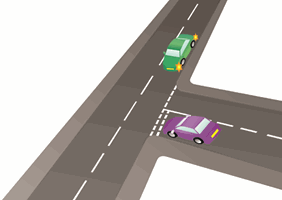
B
C
D
Correct Answer: D
Explanation: Other road users may give misleading signals. When you're waiting at a junction don't emerge until you're sure of their intentions.
Explanation: Other road users may give misleading signals. When you're waiting at a junction don't emerge until you're sure of their intentions.
Correct Answer: A, D
Explanation: Distractions which cause you to take your hands off the steering wheel or your eyes off the road are potentially dangerous. You must be in full control of your vehicle at all times.
Explanation: Distractions which cause you to take your hands off the steering wheel or your eyes off the road are potentially dangerous. You must be in full control of your vehicle at all times.
Correct Answer: B
Explanation: Rear fog lights shine brighter than normal rear lights so that they show up in reduced visibility. When the weather is clear they could dazzle the driver behind, so switch them off.
Explanation: Rear fog lights shine brighter than normal rear lights so that they show up in reduced visibility. When the weather is clear they could dazzle the driver behind, so switch them off.
Correct Answer: D
Explanation: Extra care should be taken in wet weather as, on wet roads, your stopping distance could be double that necessary for dry conditions.
Explanation: Extra care should be taken in wet weather as, on wet roads, your stopping distance could be double that necessary for dry conditions.
Correct Answer: D
Explanation: Leaving your indicators on could confuse other road users and may even lead to a crash. Be aware that if you haven't taken a sharp turn your indicators may not self-cancel and you will need to turn them off manually.
Explanation: Leaving your indicators on could confuse other road users and may even lead to a crash. Be aware that if you haven't taken a sharp turn your indicators may not self-cancel and you will need to turn them off manually.
Correct Answer: B
Explanation: Don't use hazard lights as an excuse for illegal parking. If you do use them, don't forget to switch them off when you move away. There must be a warning light on the control panel to show when the hazard lights are in operation.
Explanation: Don't use hazard lights as an excuse for illegal parking. If you do use them, don't forget to switch them off when you move away. There must be a warning light on the control panel to show when the hazard lights are in operation.
Correct Answer: B
Explanation: Always switch off the engine, remove the key and lock your car, even if you are only leaving it for a few minutes.
Explanation: Always switch off the engine, remove the key and lock your car, even if you are only leaving it for a few minutes.
Correct Answer: A, E
Explanation: For short journeys it may be quicker to walk, or cycle, which is far better for your health. Time spent stationary in traffic with the engine running is damaging to health, the environment and expensive in fuel costs.
Explanation: For short journeys it may be quicker to walk, or cycle, which is far better for your health. Time spent stationary in traffic with the engine running is damaging to health, the environment and expensive in fuel costs.
B
C
D
Correct Answer: B
Explanation: If any object falls onto the motorway carriageway from your vehicle pull over onto the hard shoulder near an emergency telephone and phone for assistance. Don't stop on the carriageway or attempt to retrieve anything.
Explanation: If any object falls onto the motorway carriageway from your vehicle pull over onto the hard shoulder near an emergency telephone and phone for assistance. Don't stop on the carriageway or attempt to retrieve anything.
Correct Answer: B, E
Explanation: Allow the traffic to merge into the nearside lane. Leave enough room so that your separation distance is not reduced drastically if a vehicle pulls in ahead of you.
Explanation: Allow the traffic to merge into the nearside lane. Leave enough room so that your separation distance is not reduced drastically if a vehicle pulls in ahead of you.
Correct Answer: B
Explanation: When driving a motor car, a learner driver who holds a provisional driving licence must
- display red L plates (or D plates in Wales) to the front and rear of the vehicle
- be insured to drive the vehicle
- be accompanied by someone who's at least 21 years old and who has held for at least three years (and still holds) a full licence for the category of vehicle being driven.
Explanation: When driving a motor car, a learner driver who holds a provisional driving licence must
- display red L plates (or D plates in Wales) to the front and rear of the vehicle
- be insured to drive the vehicle
- be accompanied by someone who's at least 21 years old and who has held for at least three years (and still holds) a full licence for the category of vehicle being driven.
47. You are parked in a busy high street. What is the safest way to turn your vehicle around so you can go the opposite way?
Mark one answer
B
C
D
Correct Answer: C
Explanation: Make sure you carry out the manoeuvre without causing a hazard to other vehicles. Choose a place to turn which is safe and convenient for you and for other road users.
Explanation: Make sure you carry out the manoeuvre without causing a hazard to other vehicles. Choose a place to turn which is safe and convenient for you and for other road users.
Correct Answer: B, C
Explanation: Don't just take someone's word that they are qualified to supervise you. The person who sits alongside you while you are learning should be a responsible adult and an experienced driver.
Explanation: Don't just take someone's word that they are qualified to supervise you. The person who sits alongside you while you are learning should be a responsible adult and an experienced driver.
49. You are carrying a child using a rear-facing baby seat. You want to put it on the front passenger seat. What MUST you do before setting off?
Mark one answer
B
C
D
Correct Answer: C
Explanation: You MUST deactivate any frontal passenger airbag when using a rear-facing baby seat in a front passenger seat. It is ILLEGAL if you don't. If activated in a crash it could cause serious injury or death. Ensure you follow the manufacturers instructions. In some cars this is now done automatically.
Explanation: You MUST deactivate any frontal passenger airbag when using a rear-facing baby seat in a front passenger seat. It is ILLEGAL if you don't. If activated in a crash it could cause serious injury or death. Ensure you follow the manufacturers instructions. In some cars this is now done automatically.
Correct Answer: C
Explanation: On the approach to tunnels a sign will usually show a local radio channel. It should give a warning of any incidents or congestion in the tunnel ahead. Many radios can be set to automatically pick up traffic announcements and local frequencies. If you have to tune the radio manually don't be distracted while doing so. Incidents in tunnels can lead to serious casualties. The greatest hazard is fire. Getting an advance warning of problems could save your life and others.
Explanation: On the approach to tunnels a sign will usually show a local radio channel. It should give a warning of any incidents or congestion in the tunnel ahead. Many radios can be set to automatically pick up traffic announcements and local frequencies. If you have to tune the radio manually don't be distracted while doing so. Incidents in tunnels can lead to serious casualties. The greatest hazard is fire. Getting an advance warning of problems could save your life and others.





